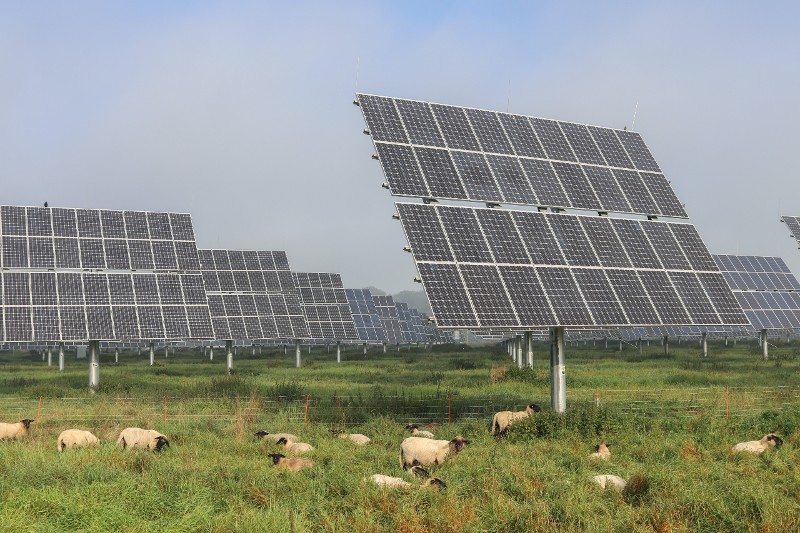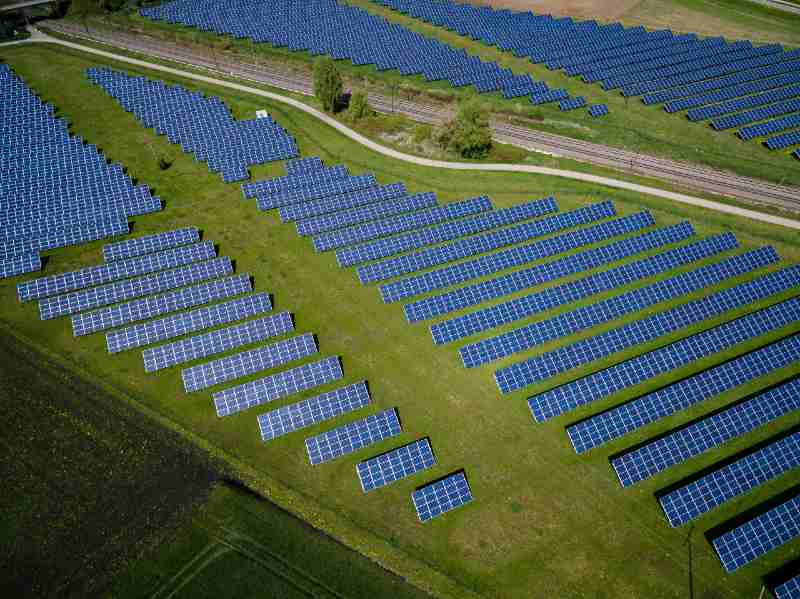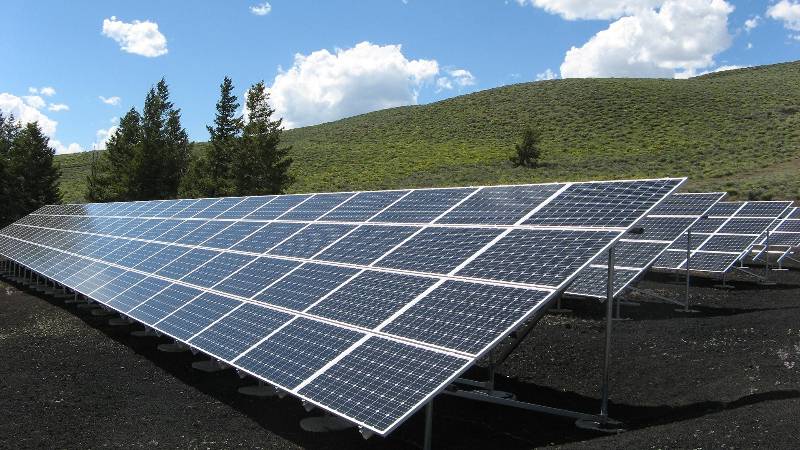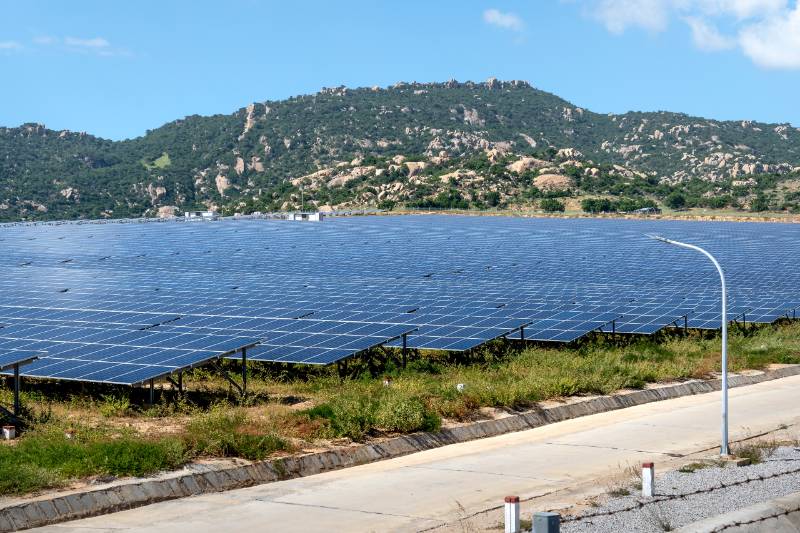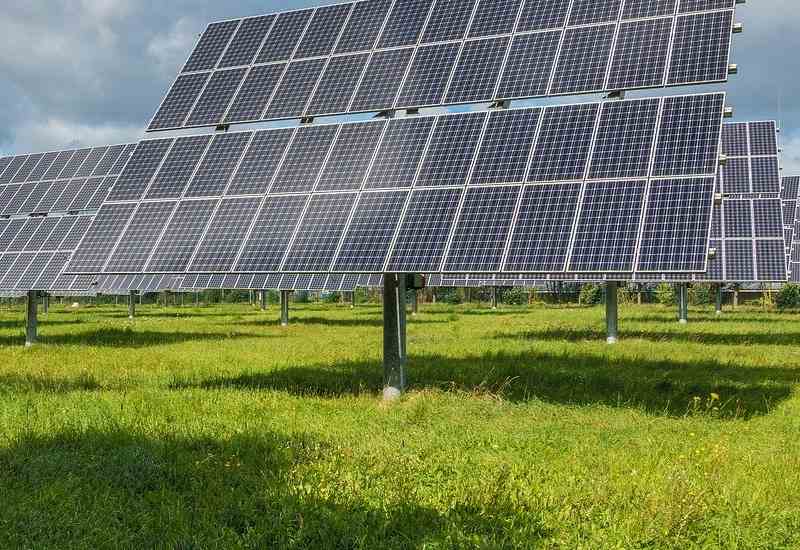Right now, there are over 2,500 solar farms in the United States alone.
These farms are powering more than 255,000 American homes and it’s estimated that they’re offsetting the emissions of more than 2 million cars.
That sounds pretty good but what are solar panel farms exactly?
Well, solar farms are simply solar power plants.
They consist of thousands of solar panels working together to generate clean electricity to power homes and businesses.
If you need to learn more on what are solar farms and how they work, then you are just in the right place!
In this blog post, we’ll cover the types of solar farms, how they generate electricity, how much land they require, and how much money they make.
Key Takeaways
- A solar farm is a large area of land, usually tens of acres covered with solar panels to collect the sun’s energy and produce electricity.
- There are two types of solar farms — utility solar farms and community solar farms
- Utility solar farms are large-scale solar farms built by utility companies to sell the generated electricity to consumers.
- Important factors for choosing a solar farm site include the availability of land, sunlight exposure, proximity to power lines, and environmental impact.
- You need about 5-10 acres of land per Megawatt (1,000 kW) of solar power.
- Solar farms cost between $850,000 and $1.07 million per Megawatt of power.
- A 1-megawatt solar farm can make $121,263 per year.
- The largest solar farm in the world is the Bhadla Solar Park in Rajasthan, India.
What Is a Solar Farm?
A solar farm is a large-scale power generation facility that’s like a power plant, but instead of burning fossil fuels, it uses the sun to make electricity.
Picture this: a massive area, sometimes hundreds of acres big, packed with rows upon rows of shiny solar panels.
This power is then fed into the national grid, where it’s distributed to light up homes and power businesses all around.
How Does a Solar Farm Work?
A solar farm works by capturing sunlight using photovoltaic (PV) panels.
These panels contain solar cells, usually made from silicon, that convert light into electrical energy.
When sunlight hits these cells, it causes electrons to move, creating direct current (DC) electricity.
However, DC electricity isn’t what we use in our homes and businesses; we need alternating current (AC).
That’s where an inverter comes into play within the solar farm’s setup.
The inverter’s job is to take the DC electricity produced by the solar panels and convert it into AC electricity, which is suitable for everyday use.
After conversion to AC, the electricity doesn’t head straight to our homes yet.
It first travels through a network of substations and transformers.
They adjust the electricity’s voltage to levels that are safe and effective for distribution across the power grid.
After these adjustments, the electricity is distributed to end consumers, lighting up homes, running appliances, and powering businesses.
What Are the Different Types of Solar Farms?
1. Utility-Scale Solar Farms
Utility-scale solar farms are big installations filled with lots and lots of solar panels, often spreading across large areas of land.
Private companies or utility companies usually build and take care of these solar farms.
Their main job?
To produce a whole lot of electricity from the sunlight these panels capture.
Once they’ve generated this electricity, they don’t just keep it; they sell it.
This electricity goes out through the national grid, reaching homes and businesses all over the place.
And the goal here is to make money by selling the electricity they produce.
2. Community Solar Gardens
Community solar farms, or solar gardens, are smaller than those huge utility-scale solar farms you might have heard about.
They’re all about local power for local people.
Here’s how it works: instead of each person trying to fit solar panels on their roof, a group of neighbors come together to create a small solar farm or buy into part of a bigger one nearby.
Each person or business that puts money into the solar farm gets energy credits in return.
The amount of credit you get depends on how much you invest and how much electricity the solar farm produces.
These credits can be quite handy—you can use them to lower your electricity bills.
You can even sell these credits back to the electricity company if you end up with more than you need, thanks to something called virtual net metering.
What Factors to Consider When Selecting a Site for Solar Farms?
1. Land Availability
When planning to set up a solar farm, one of the key factors to consider is the amount of land you have available.
Commercial solar panels used in these projects are quite sizeable, each covering about 21.6 square feet.
This means you can fit roughly 1,500 solar panels on a single acre.
But it’s not just the panels themselves that need space.
You also need to think about the gaps between panels and room for essential equipment like racking hardware, inverters, and wiring.
To put it into perspective, generating 1 Megawatt (1,000 kW) of power requires between 5 to 10 acres of land.
So, for an average solar farm size of about 5 Megawatts, you’re looking at needing at least 25 acres.
2. Access to Solar Irradiation
The second, and possibly the most important factor when picking a spot for your solar farm, is how much sunlight the area gets.
It’s all about the sun for solar panels because they need it to make electricity.
The more sun they catch, the more power they generate, which means more money in your pocket.
But it’s not just about choosing the sunniest place you can find.
The temperature of the location matters a lot too.
While you want plenty of sunlight, too much heat can make the solar panels less efficient.
High temperatures can mess with the way the panels convert sunlight into electricity, which means you’d get less power out of them.
So, when you’re looking for the perfect spot for your solar farm, look for a place that’s not only sunny but also cool enough to keep those panels working at their best.
3. Proximity to Power Transmission Lines
When you’re picking a spot for your solar farm, one of the big things to think about is how close you are to three-phase distribution lines.
These lines are super important because they carry the electricity your solar farm produces straight to the grid.
If you’re close to these lines, hooking up your solar farm to the main electrical network is much easier, meaning the electricity gets to the people who need it smoothly and efficiently.
Now, if the site you’re eyeing is far from these lines, you’re looking at some hefty extra costs.
Extending those lines to reach your farm isn’t just expensive; it can also push back your timeline.
Plus, the longer your electricity has to travel, the more you’ll lose along the way.
This can eat into your farm’s efficiency and how much profit you can make.
4. Environmental Impact Assessment
Although solar farms reduce our use of fossil fuels and fight climate change, we’ve got to think about their environmental impacts before setting one up.
That’s where an Environmental Impact Assessment (EIA) comes into play.
These assessments help us understand and lessen any harmful effects a new solar farm might have on its surroundings.
One major issue is how much land they need.
For instance, to produce the same amount of electricity as a natural gas plant, a solar farm might require up to 500 acres, while a gas plant might only need about 30 acres.
Often, this land is in sunny spots that were once used for farming or are important for local wildlife.
Setting up big solar farms on these lands can mess with animal habitats, lead to cutting down forests, and negatively impact food production.
But it’s not all doom and gloom.
Some solar farms are built on land that’s already been disturbed by things like mining or logging, so they don’t cause much additional environmental stress.
What’s more, the spaces between the solar panels can be used for farming or letting animals graze, a cool idea known as agrivoltaics.
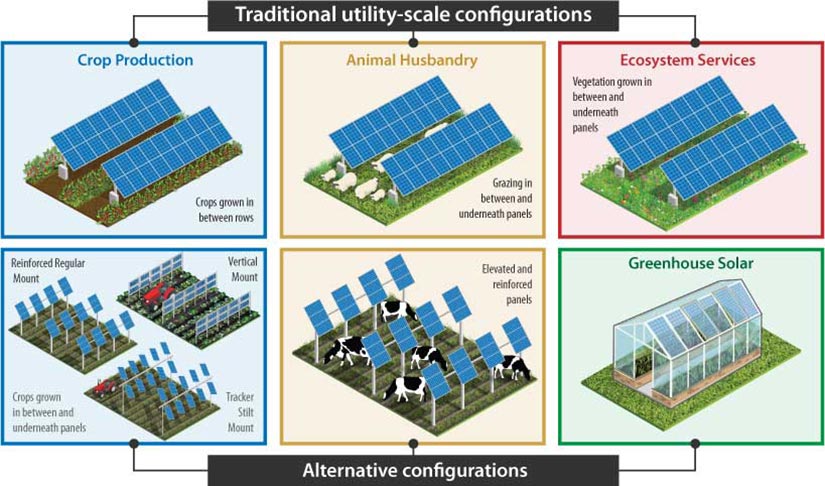
This approach allows farmers to use less fertile land for the panels while keeping their more productive land for traditional farming, which helps them economically.
Solar farms also tend to be easier on the environment than traditional power plants.
They don’t emit pollutants, they’re pretty quiet, and they don’t need much upkeep.
Plus, they help us rely less on energy from other countries, which is a big plus for our national security.
However, there’s a real concern about how solar farms might affect local wildlife.
The noise, lights, and even the physical structures can disturb animals living nearby.
This is why there should be careful planning and community engagement when selecting a site for a solar farm.
To address these concerns, developers often work with environmental experts and local authorities to design solar farms that minimize their impact on wildlife and the landscape.
What Are the Phases of Designing and Building Solar Farms?
1. Selection of Solar Panel Models and Layout
When setting up a solar farm, picking the right solar panels is important because it affects how much power you’ll generate.
You’ve got to weigh your options regarding the type of panels, taking into account how efficient they are, how long they’ll last, and how much they’ll cost you.
First up, we have monocrystalline solar panels.
These are top-notch because they’re made from a single crystal structure.
This makes them good at converting sunlight into electricity, which is exactly what you want in a solar panel.
They’re a bit pricey, but they tend to last longer, so they could be worth the investment if you’re looking for quality and durability.
Then there are polycrystalline solar panels, which are made from several crystals.
They’re cheaper than monocrystalline panels but also a bit less efficient.
If you’re watching your budget, these could be a good choice because they still do a decent job and cost less upfront.
There’s also something pretty cool called bifacial solar panels.
These can grab sunlight from both sides, which means they can generate more power.
They cost more than the usual panels, but the extra efficiency might make up for the higher price tag in the right setup.
As for how you arrange these panels, you’ve got two main choices: fixed-tilt systems and tracking systems.
With a fixed-tilt system, your panels are set up at a specific angle to catch the most sun over the year.
It’s simpler and cheaper to install and maintain this kind of setup.
On the other hand, tracking systems let your panels move to follow the sun during the day.
They’re more expensive, but they can catch a lot more sunlight, which boosts your farm’s power output, especially in sunny areas.
I like to go with monocrystalline panels paired with tracking systems, especially if we’re talking about a place that gets a lot of sun.
Sure, this setup might hit your wallet harder at the start, but the extra cost is worth it.
Over time, you’ll see that these panels produce more power and keep doing it for longer than other types.
2. Electrical Infrastructure and Elements
Once you’ve chosen your solar panels and figured out where they should go, the next big step is to set up the electrical infrastructure that ties everything together.
First up, you need inverters.
These are crucial because they convert the direct current (DC) from your solar panels into the alternating current (AC) that powers homes and businesses.
Picking the right inverters is key because they need to handle this conversion efficiently.
You’ll also need to connect all the panels to these inverters and each other, using high-quality wiring to minimize any electricity loss and to keep everything running smoothly no matter the weather.
Next, you’ll install transformers and substations that boost the voltage of the electricity so it can travel long distances without losing strength.
Safety is super important, too, so you’ll include protection systems like circuit breakers and safety switches to deal with any electrical faults or surges and keep everyone safe.
To make sure your solar farm stays in tip-top shape, you’ll set up monitoring systems to keep an eye on things like voltage and power output.
This helps spot any issues quickly so they can be fixed before they become big problems.
And although it’s optional, adding battery storage is a smart move.
Batteries can store any extra power you make when the sun’s shining bright, which you can then use on cloudy days or during peak demand times.
3. Base and Support Framework
Once you’ve picked out your solar panels and sorted out the electrical setup, the next step is to get into the base and support framework.
This is all about making sure your solar panels are stable and set up in the most effective way possible.
Let’s talk about the different types of mounting systems you might consider.
If you have a big, open space that’s fairly flat, a ground-mounted system is probably the way to go.
These are installed right on the ground and can be tilted to catch the best angles of sunlight throughout the year, maximizing your solar intake.
If you’re planning to put solar panels on a building, you’ll need a rooftop-mounted system.
This setup has to be done carefully.
You need to make sure the weight of the panels is evenly distributed so it doesn’t mess up the roof’s structure.
It’s all about keeping things balanced and secure up there.
In areas where ground space is tight or the terrain is a bit tricky, pole-mounted systems are a great choice.
These raise your panels on poles or posts, which can help you avoid issues on the ground and sometimes even get a better angle to the sun, depending on where you are.
And if you’re in a spot with lots of sun and where the sun’s position changes a lot during the day, you might want to consider tracking systems.
These are pretty high-tech because they have motorized mounts that move your panels to follow the sun as it travels across the sky.
Yes, they’re more expensive, but they can bump up how much power you generate by keeping your panels aimed right at the sun all day long.
Choosing the right mounting system depends on what your site is like, how much you can spend, and how much power you need to produce.
For example, since I live in sunny California with its varied landscape, I would opt for tracking systems in more open, sun-drenched areas to maximize solar capture throughout the day.
In more urban or hilly regions, pole-mounted systems could be ideal to elevate the panels above any obstructions and take advantage of whatever sunlight is available.
4. Safety Measures and Entry Management
The last step in setting up your solar farm is all about making sure everything and everyone on the site is safe and secure.
This is super important because solar farms are often in remote areas, which makes them targets for theft, vandalism, and other nasty stuff.
To tackle these risks, you need to beef up security around the place.
Start with solid fencing around the entire perimeter of the farm.
Add some secure gates and barriers at all the entrances to control who comes in and out.
You’ll also want to install a bunch of surveillance cameras.
These cameras let you keep an eye on the farm from afar and record any sketchy behavior, helping security folks react quickly and effectively.
But security isn’t just about keeping out trespassers; it’s also about controlling who gets to access certain parts of the farm.
This is where access controls come into play.
You could use key cards or even high-tech biometric systems like fingerprint or facial recognition to ensure only the right people can get into the more sensitive areas of the farm.
On the digital side, ensure you have secure systems for accessing the farm’s data, like how much power you’re producing or how well the systems are running.
This helps protect against cyber threats.
What Are the Operational and Maintenance Needs of a Solar Farm?
1. Tracking System Performance
After setting up your solar farm, it’s not a good idea to just set it and forget it.
You need to keep a close watch on how it’s doing.
Setting up a strong monitoring system is the way to go because it lets you keep tabs on everything important.
This means checking how well your equipment works, how much power your panels are putting out, and how the weather might impact your energy production.
This way, you can spot any problems right away, whether it’s a panel that’s not doing its job or a sudden drop in power output because of equipment issues.
I recommend setting up automated monitoring tools that can alert you to these issues in real-time.
This makes it easier to manage your solar farm efficiently without having to be on-site all the time.
2. Cleaning Solar Panels
Let’s not forget that, in the end, the performance of solar farms hinges on how clean and efficient the solar panels are.
How often you’ll need to clean them can vary—usually, it’s about 1-2 times a year, but if you’re in a dustier spot, you might need to do it more often.
When it comes to cleaning, you’ve got to think about what best fits the size of your farm and your specific needs.
Automated cleaning systems are your best friend if you’ve got a lot of ground to cover.
They use things like water jets or rotating brushes and can clean loads of panels quickly and with little effort from you.
On the other hand, if your farm is on the smaller side or your panels need a gentler touch, going manual might be the way to go.
Using a soft brush or a squeegee lets you get up close and personal with each panel, which is great for tackling more stubborn spots like bird droppings or built-up dirt.
And speaking of tough stains, there are special cleaning agents made just for solar panels that can make a difference.
They’re designed to clean effectively without harming the panel’s surface, which is important for maintaining their efficiency over time.
If you do find something wrong during these check-ups, a lot of times you can fix the broken parts instead of having to replace them completely.
3. Equipment Repair and Replacement
Running a solar farm is similar to taking care of your home solar setup, just on a way bigger scale.
You’ve got to regularly check each part of your solar farm—from the panels to the inverters—to make sure everything’s working right.
Look out for any signs of wear, damage, or anything else that might mess with how well your system works.
Say a converter isn’t doing its job right; fixing it could be cheaper than getting a new one.
Or if just a few solar panel cells are busted, you can just swap out those cells instead of the whole panel.
But make sure you have skilled pros handling these repairs.
They know what they’re doing and have the right tools to get the job done safely and effectively.
How Much Does It Cost to Build a Solar Farm?
It costs about $850,000 to $1.07 million to set up 1 Megawatt (MW) of solar power, according to the Solar Energy Industries Association (SEIA).
That’s because the equipment and installation for solar farms usually run between $0.85 and $1.07 per watt.
This cost covers everything, including solar panels, inverters, and other key hardware, plus the costs of installing and hooking everything up to the grid.
For example, if you plan to build a typical solar farm around 5 Megawatts, your total upfront cost would be somewhere in the ballpark of $5 million.
Of course, this is just a ballpark figure.
The actual cost could vary based on some factors such as the specific technology used, the site’s geographical location, and the local cost of labor.
How Much Money Can You Make out of a Solar Farm?
You can earn about $100,000 per year from each megawatt of capacity in your solar farm if you get an average of 5 peak sun hours each day.
Here’s how it works: a 1-megawatt solar farm can produce roughly 1,425 megawatt-hours (MWh) of electricity over a year.
If you sell that electricity at the average wholesale rate of $83 per MWh, you’ll see those kinds of returns.
Keep in mind, though, that your actual earnings might change based on the electricity prices and market conditions where your farm is located.
Now, if you’re part of a community solar farm, the financial perks can be even more appealing.
Typically, you could save at least double what you invested into the farm.
This comes from lower electricity bills and other benefits from putting your money into green energy.
What Are the Largest Solar Farms in the World?
With so much demand for clean energy, more and more investors are turning to solar farms.
Currently, some of the largest solar farms in the world include:
- Bhadla Solar Park: Currently, the largest solar farm in the world is the Bhadla Solar Park in Rajasthan, India with a capacity of 2,245 Megawatts. This farm is spread over 14,000 acres with an estimated cost of $1.3 billion.
- Huanghe Hydropower Hainan Solar Park: The second largest solar park in the world is in Golmud, China with a capacity of a little over 2,200 Megawatts and 1,390 acres of land with an estimated cost of $2.3 billion.
- Pavagada Solar Park: The third largest solar farm in the world is also located in India with a capacity of 2,050 Megawatts spread over 13,000 acres of land. This huge project cost $2 billion and provides electricity to more than 1 million Indian homes.
- Benban Solar Park: In number 4 we have the largest solar farm in Africa, the Benban Solar Park in Egypt. This project was sited with the help of NASA and it consists of more than 7.2 million photovoltaic panels with a capacity of 1,650 Megawatts. The project cost $4 billion and it’s constructed on 9,192 acres of land.
- Tengger Desert Solar Park: Another solar park in China is the Tengger Desert Solar Park with a capacity of 1,547 Megawatts and an estimated cost of $2.2 billion. This project first became operational in 2017 and it now powers more than 4 million Chinese homes.
FAQs
What Is the Basics of Solar Farm?
A solar farm is a large installation of solar panels on land that converts sunlight into electricity, which is then distributed through the power grid.
What Are the Best Conditions for Solar Farms?
The best conditions for solar farms include areas with high solar irradiation, moderate temperatures, and proximity to power transmission lines to minimize energy loss.
How Much Does a 1 Acre Solar Farm Cost UK?
A one-acre solar farm costs in the UK between £850 to £1,100 per acre per annum, varying by the farm’s size and location, without relying on subsidies.
Conclusion
As promised, we’ve covered the basics of what a solar farm is, how it works, and the different types available.
We also looked at the best conditions for setting up a solar farm, what to consider when choosing a location, and the costs involved.
Still, here’s a piece of advice: if you’re considering investing in a solar farm, start small.
Perhaps join a community solar project to gain insight and experience before committing to a larger-scale operation.
I also prefer conducting a detailed cost-benefit analysis to ensure that the investment aligns with your financial goals.


